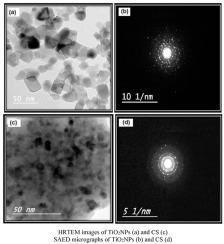Journal of Physics and Chemistry of Solids ( IF 4.3 ) Pub Date : 2021-02-03 , DOI: 10.1016/j.jpcs.2021.109983 Elham M. Hussein , Waled M. Desoky , Magda F. Hanafy , Osiris W. Guirguis

|
The solution casting method was used to prepare nanocomposite films of chitosan/TiO2 nanoparticles (NPs) because of their applications in various fields. The effects of TiO2NP concentration on the structural, morphological, thermal, mechanical, and optical properties of such films were studied by X-ray diffraction (XRD), high-resolution transmission electron microscopy (HRTEM), field emission scanning electron microscopy (FESEM), Fourier transform infrared (FTIR) spectroscopy, and thermal analysis (thermogravimetric analysis [TGA] and differential scanning calorimetry [DSC]). The XRD patterns reveal miscibility between the amorphous components of chitosan and TiO2NPs. The HRTEM and FESEM images illustrate the distribution and dispersion of TiO2NPs on the film surface. Data from FTIR spectroscopy, DSC, and TGA and the mechanical properties indicate the dependence of chitosan properties on the presence of TiO2NPs and the existence of interactions between chitosan and TiO2NPs. The reflectance and transmittance values obtained were used to calculate the CIE tristimulus values, color parameters, refractive index, absorption coefficient, dielectric spectra, optical conductivity, volume energy loss function (VELF), and surface energy loss function (SELF). The dependence of the absorption coefficient on the photon energy demonstrated that the optical transfer is permissible and direct. The variations of the dielectric spectra and optical conductivity indicate different interactions between photons and electrons in the films produced and relate to the electronic structure. The values of the VELF were found to be greater than those of the SELF, which confirms that the energy loss occurred mostly within the material. Films were also examined for water vapor transmission (WVT) and water vapor permeability (WVP), and the results showed that incorporation of TiO2NPs onto chitosan caused a decrease of WVT and WVP. In addition, the antimicrobial activity of the nanocomposite films against Gram-positive and Gram-negative bacteria was studied, and good antimicrobial activity was found, indicating their ability to inhibit bacterial proliferation at the culture site. The developed chitosan thin films supporting an optimized amount of TiO2NPs could be used to treat various diseases.
中文翻译:

TiO2纳米粒子对壳聚糖/ TiO2纳米粒子复合材料的结构构型以及热,机械和光学性能的影响
由于其在各个领域中的应用,溶液浇铸法被用于制备壳聚糖/ TiO 2纳米颗粒(NPs)的纳米复合膜。TiO 2的效果2通过X射线衍射(XRD),高分辨率的透射电子显微镜(HRTEM),场发射扫描电子显微镜(研究NP浓度对这种膜的结构,形态,热学,机械,和光学性能FESEM),傅立叶变换红外(FTIR)光谱和热分析(热重分析[TGA]和差示扫描量热法[DSC])。XRD图谱显示壳聚糖和TiO 2 NPs的非晶态组分之间具有可混溶性。HRTEM和FESEM图像说明了TiO 2的分布和分散薄膜表面上的NP。FTIR光谱,DSC和TGA的数据以及机械性能表明,壳聚糖性能取决于TiO 2 NPs的存在以及壳聚糖与TiO 2之间相互作用的存在NP。获得的反射率和透射率值用于计算CIE三刺激值,颜色参数,折射率,吸收系数,介电谱,光导率,体积能量损失函数(VELF)和表面能量损失函数(SELF)。吸收系数对光子能量的依赖性表明,光学传递是允许的和直接的。介电谱和光导率的变化表明所生产的膜中光子和电子之间的相互作用不同,并且与电子结构有关。发现VELF的值大于SELF的值,这证实了能量损失主要发生在材料内部。还检查了薄膜的水蒸气透过率(WVT)和水蒸气渗透率(WVP),壳聚糖上的2个NP导致WVT和WVP降低。此外,研究了纳米复合膜对革兰氏阳性和革兰氏阴性细菌的抗菌活性,发现了良好的抗菌活性,表明它们在培养部位具有抑制细菌增殖的能力。支持最适量TiO 2 NPs的已开发的壳聚糖薄膜可用于治疗各种疾病。











































 京公网安备 11010802027423号
京公网安备 11010802027423号